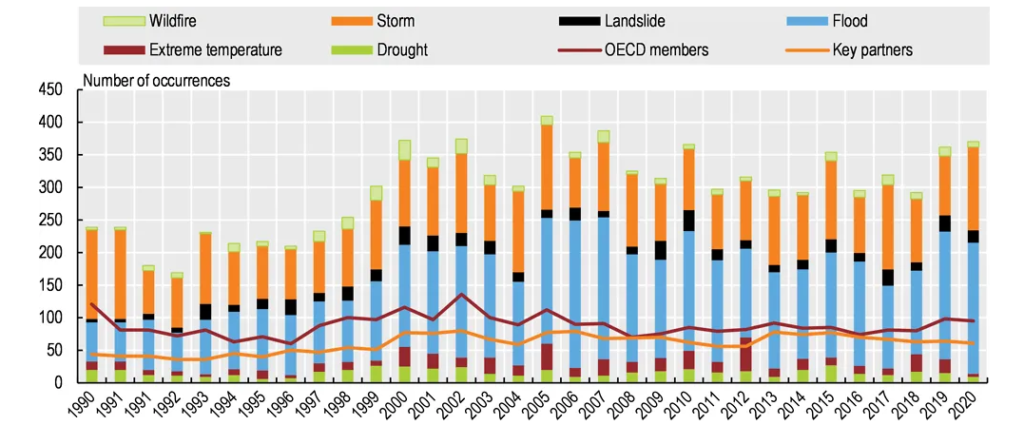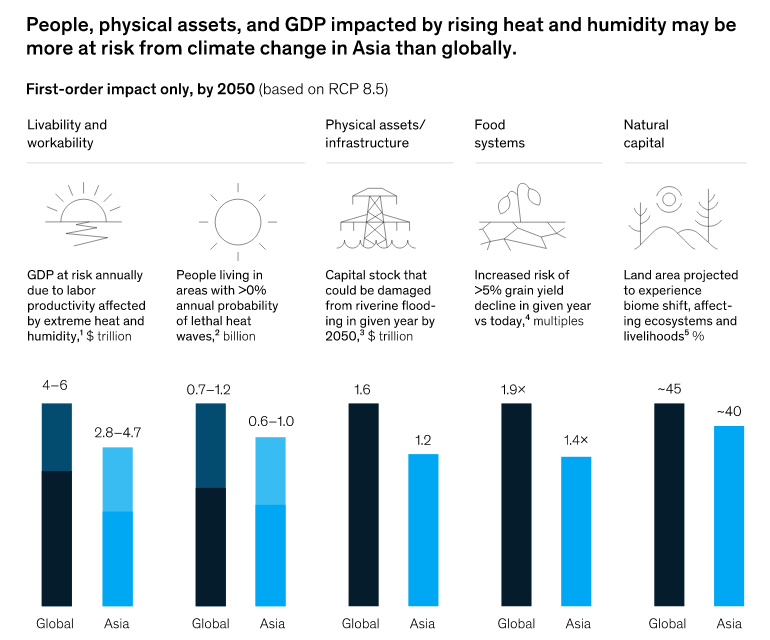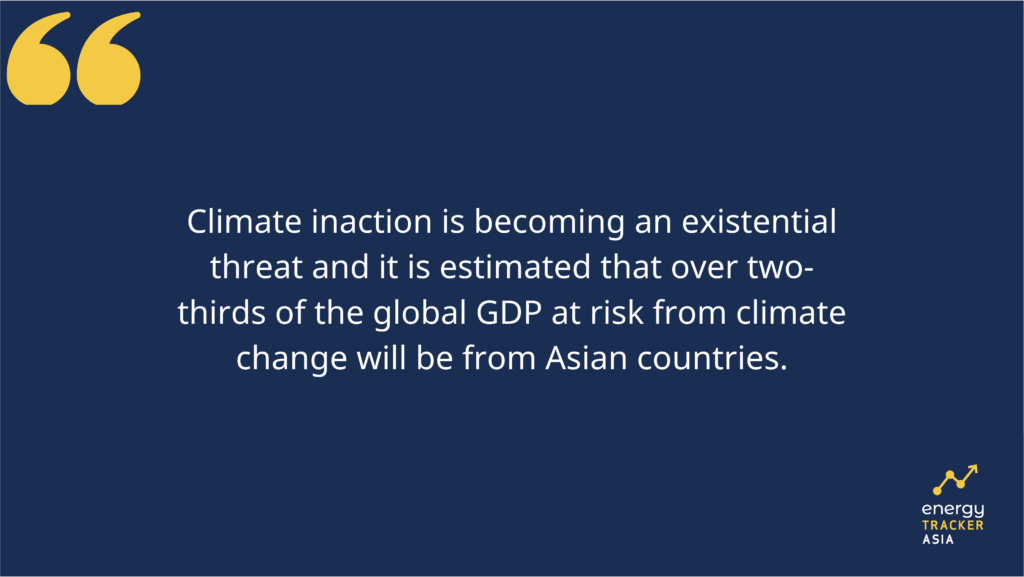The Economic Cost of Climate Inaction for Asia
01 July 2022 – by Viktor Tachev Comments (0)
Climate inaction is costly for both developed countries and developing countries globally. The difference is that rich countries can respond. On the other hand, poorer regions will struggle to pay the bill for a problem that they are the least responsible for. Unless countries start taking meaningful action toward greenhouse gas emissions mitigation, the costs will become more and more unbearable – not only for the poorest nations but also for the most powerful economies.
Climate inaction will make it impossible to achieve net-zero emissions. Without reducing the use of fossil fuels and global emissions, the transition to renewable energy systems will remain a dream.
What is Climate Inaction?
Climate inaction refers to the reluctance of governments, businesses, and individuals to address climate change. This inaction results in the accumulation of carbon dioxide and other greenhouse gases in the atmosphere, which causes global warming.
The Landscape in Asia and Effects of Climate Change
South Asia is home to 15% of the world’s poorest communities. In Southeast Asia, the pandemic has exacerbated the problem. Due to the pandemic, an additional 4.7 million are below the extreme poverty line, with 23.1 million living in extreme poverty.
According to the UN, the Asia-Pacific region has an estimated 400 million people living in extreme poverty (below USD 1.90 a day). Another 1.2 billion are living in poverty (below USD 3.20 a day).
At the same time, the world is facing increasingly frequent and intense climate hazards and extreme weather events, which are growing more severe by the day.

According to NASA, humanity should prepare for future climate change effects. These include an ice-free arctic, 1 to 8 feet higher sea levels by 2100 and stronger and more intense hurricanes. There will be more droughts and heat waves, changes in precipitation patterns, and changes to the length of each season.
Asian nations are among the most vulnerable to human caused climate change. The IPCC expects extreme precipitation and flooding to increase across most Asian regions with “medium confidence”. Furthermore, dangerous heat waves will become more common, especially in southern areas.

Furthermore, the continent stands out as being more exposed to physical climate risk than the rest of the world.
Climate change also threatens economic growth, food security, livelihoods, economic development and ecosystems in the affected areas.

The Economic Costs of Climate Inaction in Asian Countries
Over the years, leading organisations have been bringing attention to the climate risks and cost of climate inaction. The OECD warned that the severity of the climate crisis’ impacts depends on how much we act today. NASA describes the consequences as “irreversible on the timescale of people alive today”. Furthermore, the organisation expects them to worsen in the upcoming decades. The IPCC, WHO, the UN and others continue to issue reports and make stark warnings.
However, climate inaction continues. While some regions are better prepared to handle climate change’s effects and climate disasters, Asia will be at the forefront of the worst climate impacts. The continent will face environmental, social, economic and territorial threats. Southeast Asia, in particular, is especially vulnerable, with its extensive, heavily populated coastlines and large agricultural and fishery sectors. Furthermore, significant sections of the population live below the poverty line.
According to McKinsey, by 2050, between 600 million and 1 billion people in Asia will be living in areas that will be severely affected by heat waves. In Asia, the probability of the population suffering from a deadly heat wave once or more in a decade could increase by 80%.

Livestock and Agriculture
McKinsey finds that the risk of a grain yield decline of over 5% in a given year could be 1.4 times higher by 2050 for Asia compared to today.
The most notable impacts will take place in India, Pakistan and Bangladesh. The volatility of crop yields will affect Asia, causing price spikes and destabilising farmers’ incomes.
Studies show that rising temperatures will lead to increased livestock deaths due to heat stress. Аnother shock for the livestock industry will come from its dependency on the agricultural sector, where the expectations are for a decline in grain production due to the volatile climate and rising sea levels.
Fishery
Rising ocean temperatures are taking a toll on fishing yields. Between 1930 and 2010, there has been a 35% decline in seafood yields in the Sea of Japan, for example. In the Philippines, climate change will reduce fisheries’ contribution to national GDP by between 9.27% and 17.65% by 2060.
Asia will account for over 73% of global fish consumption growth by 2025. However, at the same time, the fish supply from coastal fisheries in the Asia-Pacific region will decline significantly due to adverse environmental impacts. ADB estimates that without adaptation, economic damage in the coastal zones of East Asia could cost USD 55 billion per year between 2010 and 2050.

Jobs
According to the International Labour Organisation (ILO), on a global scale, climate change will lead to the loss of 80 million full-time jobs by 2030. And this is based on a conservative scenario based upon a global temperature rise of 1.5°C by 2100. The most affected people will be those who work outside, including agricultural sector workers. The organisation predicts that 60% of working hours will be lost. This is especially concerning for the Southeast Asian region, where the agriculture and fishery sectors make up the backbone of local economies.
McKinsey finds that the rising temperatures will significantly affect people’s ability to work in the region. By 2050, an average of between USD 2.8 trillion and USD 4.7 trillion of GDP annually will be at risk due to the loss of outdoor working hours caused by the increased heat.
These impacts will be felt mostly in countries like India, Bangladesh and Pakistan. In India, for example, the number of daylight hours during which outside work will be considered unsafe will increase by 15% by 2030. Southeast Asian countries will also be significantly impacted, considering the high percentage of work taking place in outdoor and labour-intensive sectors.
Furthermore, Asian regions with lower levels of per capita GDP are most at risk from climate change impacts. While countries in this region have an increased reliance on outdoor work, their limited financial means for adaptation add to their risk.
The Worst-Case Scenario for the Economic Costs of Climate Inaction
Under the most severe scenario, The Economics of Climate Change report by the Swiss Re Institute finds that climate change will cost Asia more than a quarter (26.5%) of the region’s GDP by 2050, second only to the Middle East and Africa (27.6%).
ASEAN countries will lose 37.4% of their GDP by 2050. The GDP losses will be the lowest in Japan, with 12%, and the highest in Singapore, with 46.4%. India’s GDP will drop by 35.1%. The impact on the economic outputs of Indonesia, Malaysia and the Philippines will be 39.5%, 46.2% and 43.9%, respectively.

In another stark warning, Deloitte estimates that climate inaction will cost Southeast Asia USD 28 trillion by 2070. Without a response, the climate crisis would reduce the region’s economic potential by 7.5% annually over the next 50 years.
Furthermore, by 2050, over two-thirds of the global GDP at risk from climate change will be from Asian countries. These grim projections are the result of impacts on key sectors such as agriculture, tourism and fishing. Additionally, the climate crisis has consequences for both human health and labour productivity.
Moreover, climate-induced migration can further worsen these projections, leading to the inability of particular economic sectors to recover.
Climate inaction is becoming an existential threat. Hopefully, the economic costs will be enough to bring about change.

by Viktor Tachev
Viktor has years of experience in financial markets and energy finance, working as a marketing consultant and content creator for leading institutions, NGOs, and tech startups. He is a regular contributor to knowledge hubs and magazines, tackling the latest trends in sustainability and green energy.
Read more


